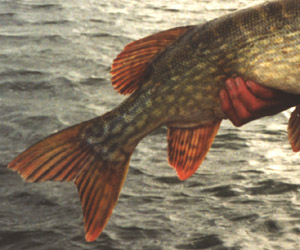|
Recognition of Individual Pike

Adult pike have markings which change very little and are as individual as fingerprints, enabling the patterns to be used to recognise individual fish. This has been proved by dye marking pike and photographing them prior to release and again on recapture*. Knowing this enables anglers to monitor the survival, movements and growth of pike as they are recaptured over time.
The markings are not identical on each side of a pike, so it is essential to compare pictures taken of the same flank of the fish in question. The markings display the most distinctive shapes and spot clusters around the tail and anal fin area, around the pelvic and pectoral fins, and on the cheeks - although markings on the flanks can also be easily recognisable. Compare the markings in two or three of these regions to ensure positive identifications as different photographs do not always show the markings in all areas equally well.
Pike exhibit three basic types of markings which are all variations of the shape and size of their pale spots; round or stellate spots, oval spots, and longitudinal bars (which could be considered elongated oval spots). It is uncommon for pike to exhibit more than one spot type in one particular water - although not unknown.
|